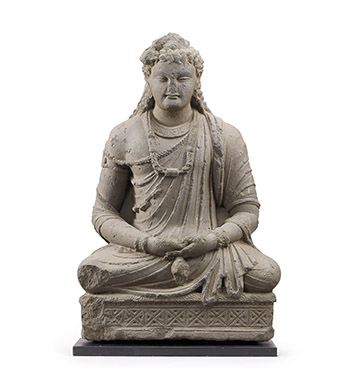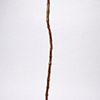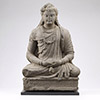Catalogue Note
Gandhara is the ancient term for the city and old kingdom of Peshawar, which encompassed the Swat valley and the Potohar Plateau regions of Pakistan, as well as the Jalalabad district of modern-day Afghanistan. During the Hellenistic period, its capital city was Charsadda, but later the capital city was moved to Peshawar by the Kushan emperor Kanishka the Great in about 127. It is mentioned in the Zend Avesta as Va.k.r.ta, the sixth most beautiful place on earth, created by Ahura Mazda. It was known in Sanskrit as Puru apura, literally meaning city of men. It was known as the crown jewel of Bactria and also held sway over Tak.a.il (modern Taxila).
The Kingdom of Gandhara lasted during the Vedic period (c. 1500– 500 BC). As a center of Greco-Buddhism, Bactrian Zoroastrianism and animism, Gandhara attained its height from the 1st century to the 5th century under the Kushan kings. The decline of the Empire left the sub-continent open to Greco-Bactrian invasions. Present-day southern Afghanistan was absorbed by Demetrius I of Bactria in 180 BC. Around about 185 BC, Demetrius invaded and conquered Gandhara and the Punjab. Later, wars between different groups of Bactrian Greeks resulted in the independence of Gandhara from Bactria and the formation of the Indo-Greek kingdom. The start of the Gandharan Greco-Buddhist art is dated to about 75–50 BC. Links between Rome and the Indo-Parthian kingdoms existed.
This stone figure shows typical Gandhara style, with the Apollostyle oval-shaped face appealing in a Greek aesthetic, brows slender and curved, nose high-arched, eyes hollowed, lips thin and pursed, morphed into a noble and calm smile. The figure’s eyes are down casted overlooking the living beings. Other characteristics include the ushnisha on the head, orderly curly hair, and long earlobes. The figure’s wearing a drapery robe, seated on a square pedestal, both hands holding a kalasa, which is also an attribute of Maitreya as a Bodhisattva. This figure has a perfect scale and a long history behind it, granting it irreplaceable historic value.
The Kingdom of Gandhara lasted during the Vedic period (c. 1500– 500 BC). As a center of Greco-Buddhism, Bactrian Zoroastrianism and animism, Gandhara attained its height from the 1st century to the 5th century under the Kushan kings. The decline of the Empire left the sub-continent open to Greco-Bactrian invasions. Present-day southern Afghanistan was absorbed by Demetrius I of Bactria in 180 BC. Around about 185 BC, Demetrius invaded and conquered Gandhara and the Punjab. Later, wars between different groups of Bactrian Greeks resulted in the independence of Gandhara from Bactria and the formation of the Indo-Greek kingdom. The start of the Gandharan Greco-Buddhist art is dated to about 75–50 BC. Links between Rome and the Indo-Parthian kingdoms existed.
This stone figure shows typical Gandhara style, with the Apollostyle oval-shaped face appealing in a Greek aesthetic, brows slender and curved, nose high-arched, eyes hollowed, lips thin and pursed, morphed into a noble and calm smile. The figure’s eyes are down casted overlooking the living beings. Other characteristics include the ushnisha on the head, orderly curly hair, and long earlobes. The figure’s wearing a drapery robe, seated on a square pedestal, both hands holding a kalasa, which is also an attribute of Maitreya as a Bodhisattva. This figure has a perfect scale and a long history behind it, granting it irreplaceable historic value.



